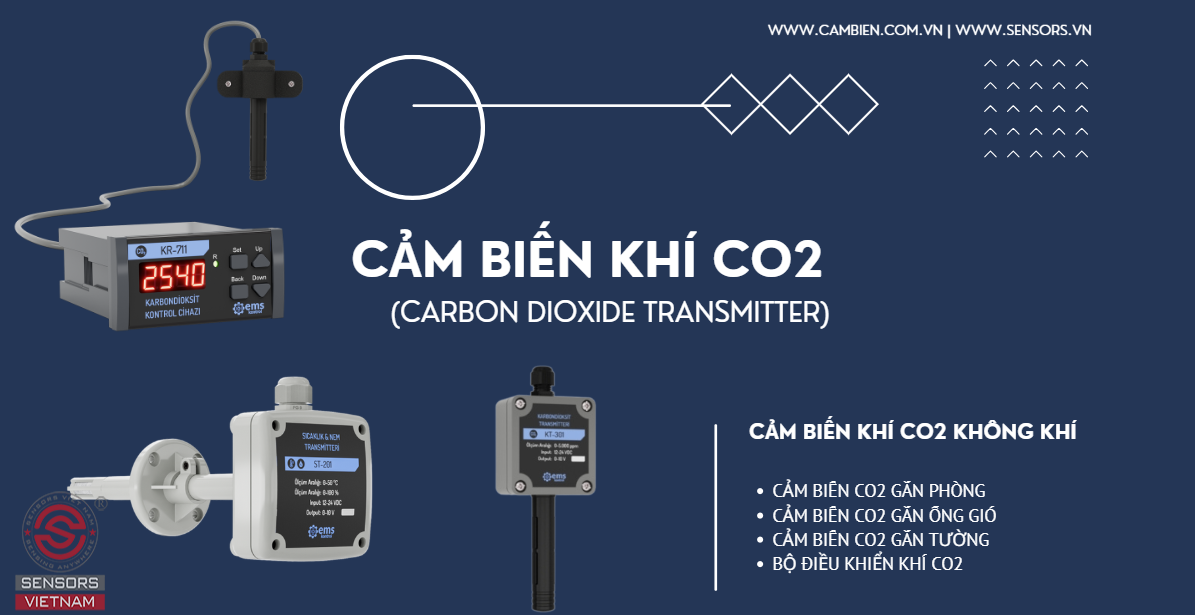CO2 Sensor, CO2 transmitter, Carbon Dioxide Detectors – Smart Solution for Indoor Air Quality Monitoring
1. Introduction to CO2 Transmitters
In recent years, the concept of Indoor Air Quality (IAQ) has gained more attention than ever. Indoor air often contains harmful gases, and among them, Carbon Dioxide (CO₂) is one of the key factors directly affecting human health, comfort, and work performance.
A CO2 sensor is a device used to measure the concentration of CO2 in the environment. With the collected data, facility managers can adjust the ventilation system, HVAC equipment, or trigger an early warning when CO2 levels exceed safety thresholds. It is considered an essential device in buildings, schools, hospitals, factories, and enclosed spaces.
2. What is a CO2 Transmitter?
A CO2 Transmitter is an electronic device designed to detect and measure the concentration of Carbon Dioxide in the air. Most CO2 Transmitters operate based on the NDIR (Non-Dispersive Infrared) principle, ensuring high accuracy and long-term stability.
Modern models often integrate additional features such as temperature and humidity measurement, allowing comprehensive indoor air quality monitoring.
3. How a CO2 Transmitter Works
• The sensor emits an infrared light beam that passes through the air sample containing CO₂.
• CO2 molecules absorb the infrared radiation at specific wavelengths.
• The reduction in light intensity is compared with reference values to calculate the CO2 concentration in ppm (parts per million).
• The measurement result is converted into output signals such as Analog (0-10V, 4-20mA) or RS485 Modbus RTU, enabling easy integration with building automation and control systems.
4. Common Types of CO2 Transmitters
4.1. Wall-mounted CO2 Transmitter
• Installation: Directly mounted on the wall, similar to a light switch.
• Applications: Offices, classrooms, meeting rooms, hospitals, shopping centers.
• Features: Compact, aesthetic design, easy installation, optional LCD display.
4.2. Duct CO2 Transmitter
• Installation: Mounted inside the air duct of HVAC systems.
• Applications: Smart buildings, factories, warehouses, commercial centers.
• Features: Probe design ensures accurate measurement in airflow; helps save energy.
4.3. Portable CO2 Detector
• Installation: Handheld, battery-powered device.
• Applications: On-site surveys, quick checks in multiple locations.
• Features: Easy to carry, real-time measurement, instant display.
5. Advantages of Using CO2 Transmitters
• High accuracy: Reliable NDIR technology with long service life.
• Improved air quality: Quick detection of high CO2 levels to ensure proper ventilation.
• Energy savings: Integrated with HVAC systems for demand-based ventilation.
• Easy integration: Compatible with PLCs and BMS through Analog or Modbus outputs.
• Health protection: Prevents fatigue, headaches, and oxygen deficiency in enclosed spaces.
6. Real-world Applications of CO2 Transmitters
6.1. In buildings and offices
CO2 Transmitters help control ventilation automatically, maintaining levels below 1000 ppm for a comfortable environment and higher work productivity.
6.2. In schools and hospitals
Maintain proper indoor air quality in classrooms and patient rooms, enhancing concentration and faster recovery.
6.3. In factories and warehouses
Ensure workers’ safety in enclosed production areas or facilities with heat-generating equipment.
6.4. In HVAC and BMS systems
Integrated into Building Management Systems (BMS), CO2 Transmitters allow ventilation and air conditioning to operate according to actual demand, preventing energy waste.
7. Key Factors to Consider When Choosing a CO2 Transmitter
• Measuring range: 0–2000 ppm, 0–5000 ppm, or up to 10,000 ppm.
• Output signals: Analog (0-10V, 4-20mA) or RS485 Modbus.
• Installation type: Wall-mounted or duct-mounted.
• Extra functions: Temperature, humidity, or VOC detection.
• Certifications: CE, RoHS, and other international standards.
8. Long-term Benefits of CO2 Transmitters
• Lower operating costs: Optimized HVAC operation reduces electricity consumption.
• Better health and productivity: Employees work more efficiently in fresh air.
• Compliance with standards: Meets IAQ, WELL, and LEED requirements for green buildings.
9. Wall-mounted CO2 Transmitter
A wall-mounted CO2 Transmitter measures CO2 concentration in indoor air and is usually installed directly on the wall. Its sleek design makes it suitable for offices, classrooms, laboratories, and other indoor environments.
Applications
• Office buildings, shopping malls
• Classrooms, meeting rooms
• Parking garages, warehouses, factories
• HVAC and BMS systems
Key Features
• Compact, aesthetic wall-mounted design
• Real-time CO2 monitoring with high accuracy
• Optional temperature and humidity measurement
• Output: Analog (0-10V, 4-20mA) or RS485 Modbus
• LCD display (optional)
10. Benefits of Wall-mounted CO2 Transmitters
• Ensure good indoor air quality, reduce oxygen deficiency.
• Save HVAC energy with demand-controlled ventilation.
• Protect health in working and learning environments.
11. Duct CO2 Transmitter
A duct CO2 Transmitter measures CO2 concentration directly in HVAC air ducts. Its probe design ensures accurate monitoring of airflow, helping optimize ventilation fan operation and energy efficiency.
Working Principle
• Uses NDIR technology to analyze CO2 concentration.
• Outputs Analog or Modbus signals for integration into BMS/PLC.
• Probe design allows accurate sampling inside air ducts.
Key Features
• Installed directly in HVAC ducts
• Real-time, high-accuracy CO2 measurement
• Typical ranges: 0–2000 ppm / 0–5000 ppm / 0–10,000 ppm
• Output: Analog (0-10V, 4-20mA) or RS485 Modbus RTU
• Optional temperature and humidity measurement
• Durable, reliable performance in harsh environments
Applications
• Office buildings, commercial centers
• Schools, hospitals
• Factories, warehouses
• Building Management Systems
Benefits
• Energy efficiency: Ventilation fans operate only when CO2 exceeds setpoints.
• Better air quality: Adequate oxygen supply, reduced stuffiness.
• Health protection: Safe and productive working environments.
• Easy integration: Compatible with modern automation systems.
CO2 Transmitters are indispensable in modern HVAC systems, ensuring proper air quality, energy efficiency, and safe indoor environments.
Today, monitoring indoor air quality is no longer optional, it is a necessity. A CO2 Transmitter is a smart solution for real-time monitoring and automated control, protecting human health, saving energy, and increasing building value.
If you are looking for reliable air quality monitoring solutions, choose from wall-mounted CO2 Transmitters, duct CO2 Transmitters, or portable CO2 detectors.
Please contact Sensors Vietnam today for expert consultation and quotations.
